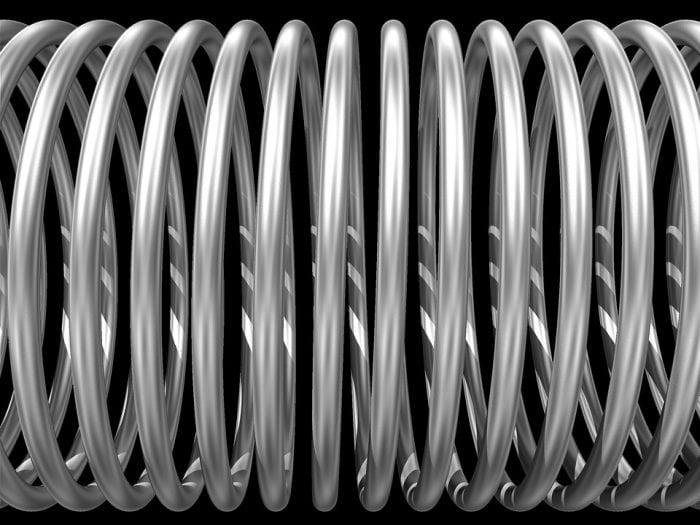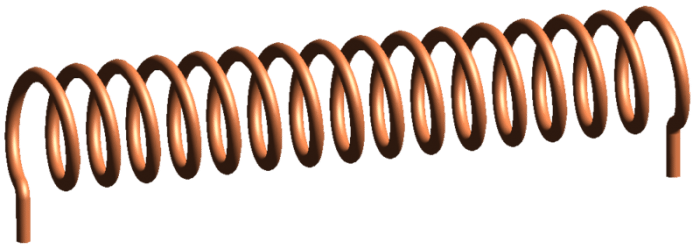
Generically, a solenoid is a length of wire/coiled wire used to create a magnetic field. It’s an electromagnet, a magnet where the magnetic field is created by an electrical current. A solenoid can also be used to refer to any object or system that can create mechanical energy out of electrical energy using the coil of wire dubbed a solenoid.
The magnetic field that solenoids produce when stimulated with electricity can be utilized to create linear motion, and as such, they are often used to power switches like those found in the ignition switches of automobiles, or in sprinkler systems.
The Function Of A Solenoid
Solenoid wires are produced in a corkscrew shape, and they are wrapped around pistons. These pistons are frequently made out of iron, though not always. Electromagnets create a magnetic field when an electric current passes through a device, and solenoids are no exception to this rule. When an electric current passes through the coil, a magnetic field is created that can then be used for a variety of purposes.
The main advantage of an electromagnet, versus a traditional static (permanent) magnet, is that electromagnets can be turned on or off, they don’t have to be always on like a regular magnet does. This means that a switch can be created by simply adding or removing an electrical current at the solenoid. This process makes them useful as valves or switches and means they can be used in automated systems. Magnets have positive and negative poles that will either attract magnetic substances to the magnet or repel them. This fact means that the piston in the center of the solenoid can be moved backward or forward, creating the motion that can be used to power a system.

Photo: Public Domain
A direct-acting valve is a solenoid based system that blocks or allows some sort of air or fluid to flow through the system. It does this by using the electrical current to activate the solenoid, which then moves a plunger or piston that would otherwise block the flow. Some solenoid valves have a setup where the electromagnetic field is one or two steps removed from the conduit, so it doesn’t open the conduit directly. These systems are referred to as pilot-operated valves. These pilot-operated valves function by having the solenoid move a plunger which only opens a small hatch, and the pressure of the air moving through this small opening is what forces the valve seal to move. Both of these systems mandate that the electric current to the solenoid is constant, and once the electrical current ceases, the valve will close again as the seal or plunger moves back into its base position.
Uses For Solenoids
Previously it was mentioned that solenoids are frequently used within automobile ignition systems. The solenoid and starter function as a relay in the system and the job of the relay is to form a closed circuit by putting metal contacts into place. When the key is turned in an ignition of a car, the starter solenoid gets stimulated with a small electric current. The magnetic field generated by the solenoid then pulls the contacts of the ignition system into place, forming a closed circuit between the starter motor and the vehicle’s battery. Once more, in order for this system to work, the solenoid needs a constant electrical current to keep the circuit complete. Yet after ignition, the engine maintains its power by itself, and the circuit is interrupted when you turn the vehicle off.
Solenoids can be used in a number of different devices, almost anything requiring a valve or a switch. They can be found in doorbells, cars, sprinkler systems, and paintball guns. For example, the sound that a chime doorbell makes is created when a small metal piston hits a tone bar. The piston is moved thanks to a solenoid that creates a magnetic field when it receives a jolt of electricity – when you push the doorbell. Incidentally, if you have a dead battery in your car and try to turn the engine on, the clicking sound you hear is frequently originating from the starter solenoid.
Different Types Of Solenoids
Here are some of the more common kinds of solenoids, along with their uses:
- Electromechanical solenoids are the type of solenoid already discussed and they are mainly used to switch things on or off and operate latches or locks.
- Pneumatic solenoids are used to control the flow of gas or air in a pneumatic device. As the solenoid operates and the passage opens or closes, the gas or air within the system is moved along to the appropriate point in the system. Pneumatic solenoids are often used to create links between pneumatic systems and the electronic devices that control the pneumatic system.
- Hydraulic solenoids function very similarly to pneumatic solenoids but they mainly control the flow of oil or other fluids as opposed to gas or air. Hydraulic solenoids are frequently used to maintain control over the movement of transmission fluid through a transmission system.
As discussed, solenoids aren’t solely electromagnetic in nature. Rather, there are many other types of solenoids like pneumatic and hydraulic solenoids. However, of the solenoids that are electrical in nature, they usually fall into two different categories. There are solenoids that rely on the use of alternating current (AC solenoids) and solenoids that rely on direct current (DC).
AC Solenoids Vs. DC Solenoids
Though DC and AC solenoids utilize different types of electric current, they operate under the same principals. The coil wires (that are insulated) end up getting stimulated with an electrical current and creating a magnetic field that attracts the rod in the center of the solenoid (once more, usually made out of steel or iron). The rod that is influenced by the magnetic field is attached to a spring, which is put under tension as the rod moves. The rod moves into the center of the coil and stays there until the electrical current ceases, keeping the spring pressurized until the current stopping releases the tension on the spring. When the tension on the spring stops, the spring snaps back into place, pulling the rod with it.
AC and DC solenoids, despite operating in the same general way, do have a number of notable differences. DC solenoids are usually substantially slower yet quieter than AC solenoids. DC solenoids are also less powerful than their AC counterparts. AC solenoids, despite being much more powerful than DC solenoids, can potentially burn out or malfunction if they stay in their stimulated electrical current position for too long. If an AC solenoid receives too much energy from the first wave of current, the device can be irreparably damaged. DC solenoids don’t see changes in currents like AC solenoids do, so they don’t risk becoming damaged in the same way. DC circuits don’t experience many problems if they are use AC solenoids, but DC solenoids can’t be used in AC circuits without having problems like overheating.








